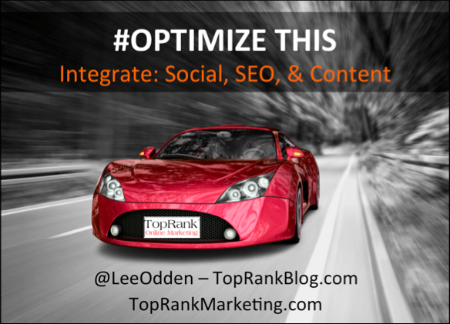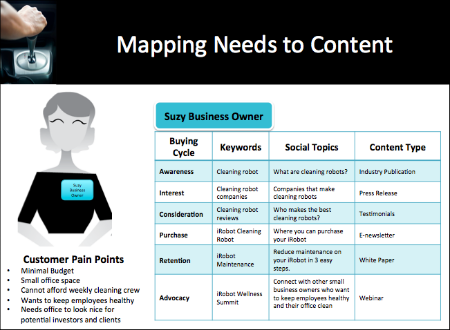
I’m headed to (hopefully) sunny San Diego today for the annual Online Marketing Summit conference where I’ll get to present on one of my favorite topics: Optimization. Of course, if you read Online Marketing Blog very often, you’ll know my definition of optimization is a bit different than traditional SEO. My post last Thursday “Are You Optimized?” touched on this.
The competition for attendance during the breakout sessions at OMS is really tough during the time slot I’m scheduled for. SAP, Wider Funnel and SAP are all presenting at the same time as I’m giving the all new “Optimize THIS: Integrating Social, SEO & Content presentation”. This post is a bit of a preview on the presentation so if you’re at OMS this week, make sure you check it out.
In Optimize THIS, I have about 45 minutes (including Q & A) to help attendees learn the principles and best practices of optimizing content and social media participation for better marketing performance. Most marketers and even consumers face a deluge of information as they look for answers online. Google has morphed itself into an entirely new type of social search engine and the state of flux has many businesses facing new challenges that are difficult to keep up with.
There’s plenty of speculation that businesses like Google that have attracted a huge user base because of their ability to organize and provide useful, relevant information see free or organic information as a problem to the advertising solution. In other words, SEO is seen as a bug, not a useful way to modify websites so search engines can crawl and index them more effectively to the benefit of all: user, brand, search engine.
Google Dominates search, but should they dominate your online marketing? What would happen if Google disappeared tomorrow? What if your business disappeared from Google tomorrow? What would that mean to your marketing? What would it mean to your business? There are numerous stories of companies devastated as collateral damage to algorithmic updates.
Google’s market position over-influences SEO practitioners to develop keyword glossaries, create, promote and optimize content solely focused on Google. That’s a reasonable approach, but I for one, am not a big fan of putting all my marketing eggs in one basket. The perceived reward of single stop marketing is also a risk.
Diversification or “Un-Googling” your online marketing isn’t just good for mitigating risk, it’s also a better approach to meeting customer needs, especially when optimization is viewed holistically with the way a business communicates digitally with its customers.
A more customer centric approach to online marketing is the catalyst for integrating content marketing, SEO and Social Media. The icing on the cake of customer centric online marketing diversification is even better organic performance on Google vs. focusing solely on traditional keyword popularity and links.

The road to Social, SEO and Content Marketing integration is through understanding the fundamental shifts in how consumers discover, consume and share information online. Search behaviors are not just inspired by a consumer need, but by paid, owned, earned and share media. The consumer journey online for solutions weaves its way through search and social interactions finding, interacting, reacting, buying and sharing.
Online commerce and content are increasingly a social experience and content is the key to helping companies Attract, Engage and Inspire their target audiences to act: purchase, interact and share with their networks.
What does a customer centric optimize content marketing approach look like? Start by identifying common customer characteristics. Segment that data and develop consumer profiles or personas that describe: Search Keywords, Social Topics, Pain Points, Triggers and Goals. Figure out what information would be most meaningful during the stages of your customer segments’ journey through the buying cycle. Essentially, find out what customers care about and leverage that data in a way that allows you to target your “best” customers as a group.
Translate what you now know about your customers into a content plan that addresses pain points, triggers and consumer goals with brand content optimized for search keywords and social topics. Implement website, blog, social content and engagement marketing to meet your target customers needs with the right context, relevant language and meaningful topics that will inspire them to take action.
Structure your content marketing plan with optimized and socialized channels of distribution. We like the hub and spoke model that can scale to a “constellation” of hub and spokes.
Monitor social channels for community response and engagement with socialized content. Use web analytics to monitor search and user experience impact of your content on engagement, fueling social network growth and of course, inspiring sales.
By formulating a content plan based on consumer segment information needs as they move through the buying cycle, optimization can be more in tune with customer interests than generic keyword popularity. Content is more helpful, usable and likely to be shared socially. For customers prone to use search, you’re visibile. For those that focus on social channels, you’re there too. For those that use both: even better.
There’s a lot more to say on this topic (as I’ve done in Optimize) but you can expect to see plenty of screen shots and some examples in my presentation tomorrow. If your’re ready to get optimized for 2012 and beyond, I hope to see you there.
2/7 OMS – San Diego
Hilton San Diego Bayfront
Optimize This: Integrating Social, SEO & Content
Learn the principles and best practices of optimizing content and social media participation for better marketing performance
11:45 AM–12:30
Room: Sapphire H


